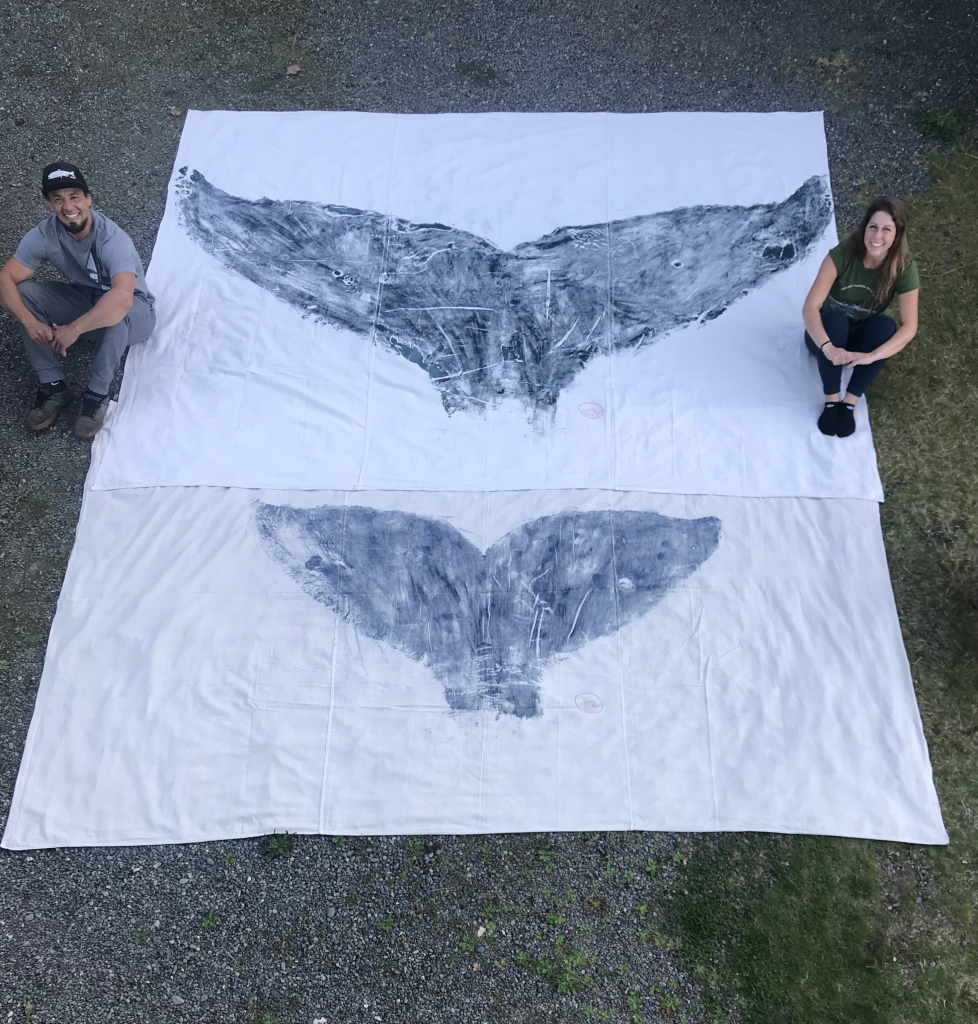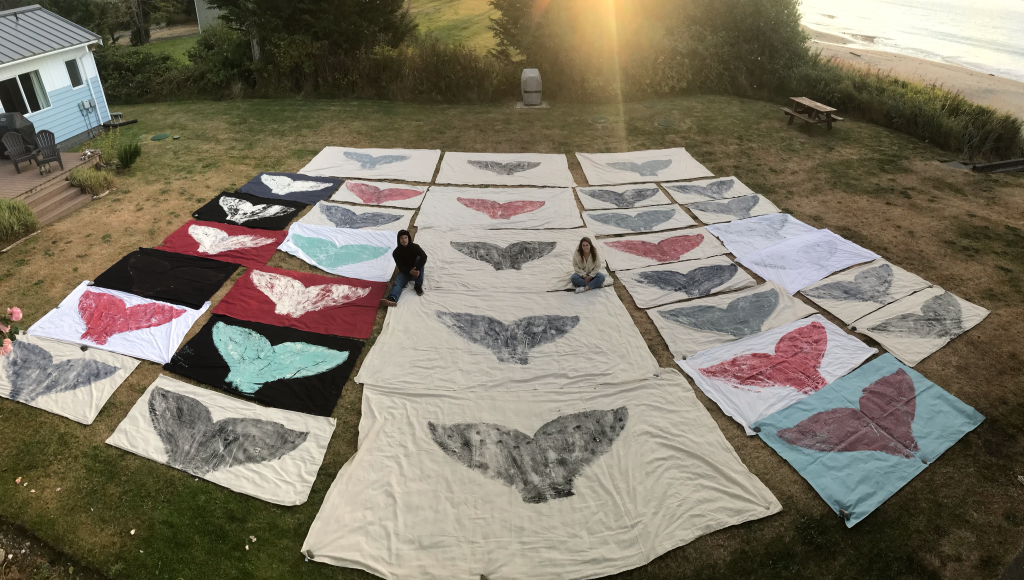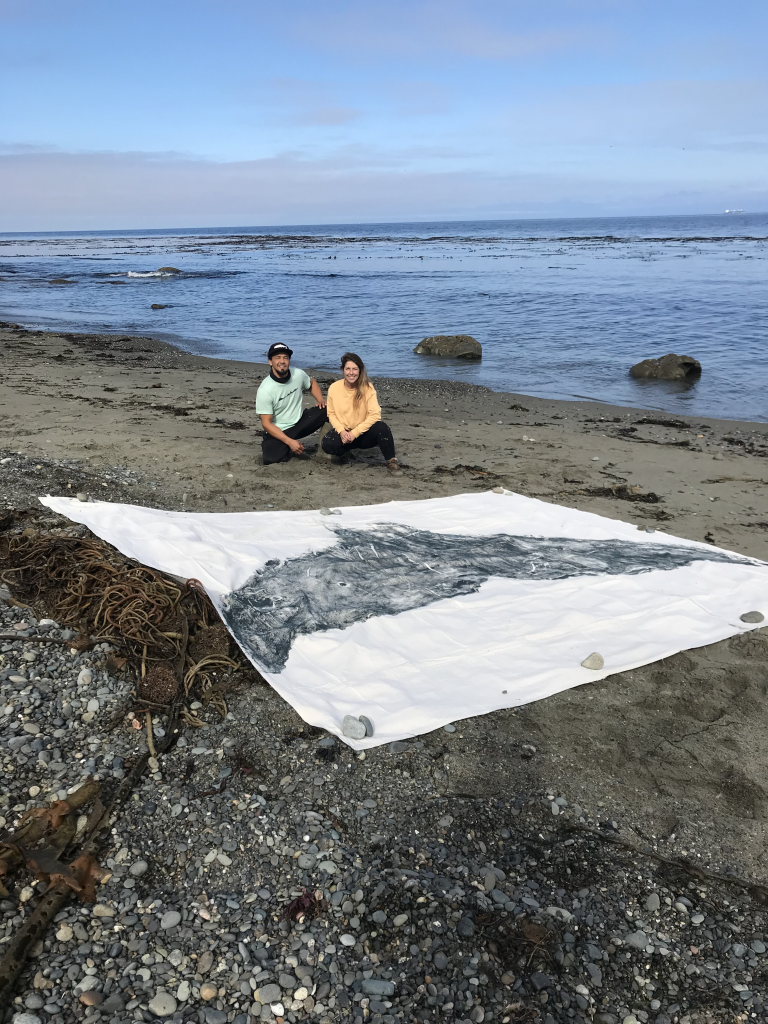We all have our own connections to the outdoors, unique lived experiences, and personal perspectives on what the outdoors means to us. These varying relationships can be due to geography, family, community, culture, income, profession, age, race, gender, sexuality, and other factors. There are a multitude of ways outdoor spaces can provide for communities, over the next few blog posts we will be focusing on different communities in Washington and their relationships to outdoor spaces.
For the third blog post of our three-part series, I caught up via Zoom with wonderful artists, water people, and couple Carolyn Votaw and Jael Marquette, who live in Neah Bay on the land of the Makah. We chatted about how the outdoors has influenced their artwork, their inseparable connection to water, their Gyotaku fish and whale tail prints, and local gray and humpback whale stories. Listening to them talk effortlessly with such passion and respect for the ocean and wildlife, and then seeing their artwork reflect their deep connection to both is something special.

Carolyn Votaw was born and raised in Edmonds, WA on the ancestral land of the Stillaguamish, Snohomish, Squamish and Coast Salish. She grew up visiting the beaches of Orcas Island (ancestral lands of the Lummi Tribe and other Salish Peoples) every summer with her family. She has endless memories of playing in the water, seeing orca whales, crabbing, and watching many beautiful vibrant sunsets from the beach. The water has always been a grounding place for her, and as an artist it has become her focal point. Carolyn went to Binghamton University and studied printmaking, which has become one of her primary mediums. Her bodies of work reflect and are influenced by her current natural space. Carolyn lives in Neah Bay where she has a small-scale printmaking business.
Jael Marquette was born and raised in Neah Bay and is a member of the Makah Tribe. Some of his earliest memories are swimming in the Tsoo-Yess River on the Makah Reservation, which leads into the Pacific Ocean, and rod and reel fishing off the rocks. He always had a keen interest in the different fisheries and charter boats in Neah Bay and further down the west coast, and became a commercial fisherman after graduating high school. He has worked for longline fisheries catching halibut and black cod, and on troll boats catching king salmon. He was also a deck hand on his brother’s dive boat, diving for sea urchins and sea cucumbers. Being a fisherman, he saw a lot of different species of fish and wanted to capture the beauty of all of them and began to practice the art of Gyotaku printing.
When you’re fishing, you’re thinking about art and when you’re making art, you’re thinking about fish. It’s very symbiotic.
Jael marquette
Jael went to Peninsula College for fisheries management. Learning the specific anatomies of the fish he was so familiar with made him appreciate his job and his art so much more. He grew up around artists and was always creative, but it wasn’t until about seven years ago that he began learning traditional native techniques and design from other woodworkers and artists in the Makah Tribe.
Caitie: What is your connection to water?
Carolyn: I was thinking about this the other day while surfing and the water slapping the underside of the surfboard and what a nice sound it was. It just evokes so many memories for me. It’s the sound of the water slapping against the dingy, it’s the sound of the water on the bottom of my dad’s boat, it’s the sound of all of my summers and now when I’m surfing. I live in a beautiful place where every night I hear the sound of the waves and it just brings back everything. Anytime I’m away from that sound, something is a little off, and then I realize I don’t hear that constant sound of the waves. That’s what kept me coming back and kept me in the place I am now.
Jael: For me growing up, the earliest memories were at the Tsoo-Yess river going out there with family, playing in the river. It didn’t matter what time of the year it was, me and my cousins and neighbors would take pedal bikes and go out to second bridge. We’d have backpacks full of cedar and newspaper and a bunch of candy and go jump off the bridge. Make a fire and find beach wood along the river bank. Few years later, my dad had a restaurant right in Neah Bay, by the marina, so I would go crabbing as a young kid and give it to the restaurant. I started filleting fish for all of the tourists when I was 12 years old. I’d go down to the docks to see if they needed help, wheelbarrowing fish up and filleting them. I started to make my own money when I was young and to keep busy and all my friends were still at the rivers, but I was down at the dock.
Caitie: How has the ocean influenced your artwork and how has your artwork influenced your connection to the ocean?
Carolyn: Having grown up around the water, it was always something that grounded me and in a way that kind of told me it’s ok to be fluid. It has always been a powerful influence for my art. Now every time we’re out on the water and I see a fish I’m thinking about the next print. Whether it’s acrylic, water color, or print making, water is always the subject matter.
Jael: Living in Neah Bay we have to live by the tides, every 6 hours there is a different tide and the weather changes so much. So, if we’re not commercial fishing there might be surfing because the weather is rough. If there’s no surf, there are certain spots I like to go fishing. When you’re fishing you’re thinking about art and when you’re making art you’re thinking about fish. It’s very symbiotic. I’m always attracted back to the water.
When they first met in Neah Bay, Jael had already been practicing Gyotaku art but he was interested in printing on materials other than paper, and Carolyn had been printing for years but did not have a lot of Gyotaku experience. Together they learned about the history and tradition of Gyotaku, which directly translated into English is “fish rubbing”, used by Japanese fisherman to keep a record of the fish they caught. They learned that as the medium evolved into an art form, rice paper, and sumi inks were traditionally used to print the fish. They also began to think about sustainability, using non-toxic ink so they can then eat the fish after printing and use the carcasses for bait for crabbing. In Neah Bay fishing is the main industry, and with Jael being Makah and a commercial fisherman, they have access to a lot of fish.
Living in Neah Bay we have to live by the tides, every 6 hours there is a different tide and the weather changes so much.
Jael Marquette
This past August 2020, a gray whale was entangled in a fishing net and brought ashore in the Makah Tribe’s usual and accustomed area. As a Makah, Jael was a part of the harvest and all of the meat and bones were distributed to the community tribal members. He received some of the bones and permission to utilize the tail. The Makah explicitly reserved their right to hunt whales within the Treaty of Neah Bay in 1855. Jael was involved in the preparation for hunt in 1999 and was on the media boat on May 17, 1999, the day the Makah were able to harvest their first whale in 70 years.
Caitie: How did you decide to print the gray whale tail?
Jael: As they were doing the processing and butchering of the whale, I was standing toward the back side and could see the tail in front of me. I was trying to get a picture, but the photo wasn’t doing it justice and something came to mind: I just wanted to print the tail.
Carolyn: We had been printing fish all summer, so of course why wouldn’t we.
Jael: Leading up to the printing we were trying to get all of the printing materials: a drop cloth big enough for the tail and the paints, and we had to go all the way to Port Angeles to get the supplies. The whole process was three- four days.
Carolyn: Starting out each print was taking us 25 minutes and by the end got it down to 5 minutes. We knew how to fold the fabric and lay the fabric, how to press it down evenly, and it was like this whole choreographed thing.

Caitie: What has been your most memorable whale sighting on the water?
Jael: An 80-foot sperm whale while we were on our 58-foot wooden boat. You could just hear this whale coming closer to our boat, and we were pulling up fish just to find only the heads of halibut were coming up. Then the whale just pops up right next to the boat, you could see all the barnacles on it.
Carolyn: I was on the paddle board right off of the beach where I live and all of a sudden, I heard a whale, and I just stopped. It was a beautiful day and the sun was shining at the perfect angle on the water so that I could see the whale from where I was. I could see it under water and it was just massive, buoyant and beautiful sitting there right under the surface. I knew I made eye contact with it, there was something that was just like we both knew we were both there in our respective spots.
It was one thing to see the whales in the water, but to see them on the beach, and to take in their full bodies was something else. Later that fall while out on beach hike, they found a humpback whale tied up 1.25 miles down a secluded beach on the Strait of Juan de Fuca.
Carolyn: The humpback tail measured 12 ft wide and it was amazing to see the difference between the humpback whale and the tail of the gray whale, which was 6.5 ft wide.
Jael: There were different type of barnacles on each one. The humpback had barnacles that stuck out off of the skin and on the gray whale they were embedded in the skin.
They found out NOAA had tied up the humpback to secure it to land because it had been floating around in the Strait for the past 10 days and they were planning to perform a necropsy on it the next day.
Carolyn: We went back the next day and packed the extra drop cloths and paint we had from the gray whale in case we got the chance to print. It was an amazing experience to watch NOAA do the necropsy. Jael explained to them that he is Makah and they said once they were finished with the necropsy that the whale would be accessible to him as it was within the usual and accustomed zone. It was just amazing to make the prints and have the impression of something that enormous and that powerful. To be able to capture that, makes your mind wonder where has that whale been? So much of its life you know nothing about; they are in their own underwater worlds. To see these little marks of events in their lives on their tails. It felt like we were preserving the spirit of the whale and wherever it had been. I think that is what comes across in the print for me.

It felt like we were preserving the spirit of the whale and wherever it had been, I think that is what comes across in the print for me.
Carolyn Votaw
Jael: Once we got all 3 prints done, I wanted to get the bones to do carving and other artwork, mainly the jaw bones. I was down there for 6 hours in the rain by myself cutting the jawbone off. I got a friend to help me pack the jawbone 1.25 miles up the trail from the beach on his ATV. A couple of days later I went back to cut the other jawbone out and I had to go down a few other times because of the incoming tides, and the smell was getting worse because the whale had been dead for two weeks. I wish I could have gotten some footage of this whole process. I also got different parts of the whale: vertebrae, ribs, scapula. There is still some of the whale at the beach but I’ve had to be aware of the king tides as it moves it, washes things away and pushes sand and rock around.
Caitie: So, you’ll be able to get more of the skeleton as it decomposes?
Jael: I’d like to get the whole skeleton of the whale and put back together. I want to preserve it for the Makah community. The woodshop teacher just got donated a gray whale skeleton from NOAA and the kids will be working on a project of putting it together. I want to volunteer and learn how to put it back together, the framing of it and everything. And to share my little bit of what I learned myself.
I want to send a big MAHALO out to Jael and Carolyn for taking the time to share their incredible stories with me. Hopefully we can get out on the water to surf together this summer! If you would like to see more of Carolyn’s and Jael’s art and their collaborations check them out here: Carolyn Votaw and Jael Marquette.
Over the past few months, I’ve loved listening to different members of the community share their experiences throughout this three-part series. Especially during a pandemic, when it can feel so isolating, it is refreshing to be able to connect and hear what others across the state are doing outside. We would love to hear more stories, if you live in Washington and would like to share your experiences please email me at caitie@wildliferecreation.org.
